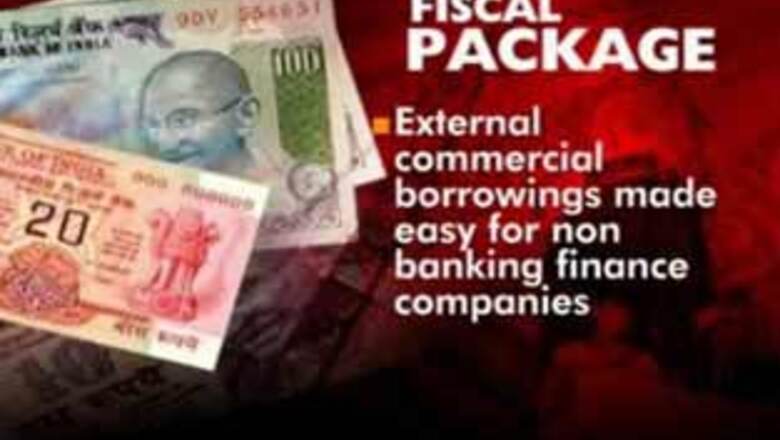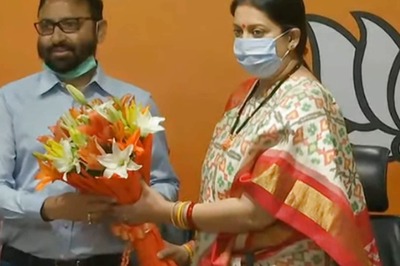
views
Stand in Finance Minister Pranab Mukherjee announced tax and duty cuts in what is being touted as the third stimulus package to help corporate India tide over the impact of global economic crisis.
The third leg of the fiscal stimulus package will cost the government nearly 30,000 crore(USD 6 billion or Rs.300 million). That's the revenue lost and is over and above the 4% cut in central value added tax announced in December, which has now been extended beyond March 31.
This comes on a day when the rating agency S&P revised its outlook on India to negative from stable. It expects FY10 deficit to remain as high as 11.1% of GDP.
Commenting on the same, Shankar Acharya, Member, Board of Governors and Honorary Professor, ICRIER, said the fiscal situation has worsened dramatically in past few months and monetisation of fiscal deficit puts risk on inflation.” Balance of Payments (BoP) situation too has deteriorated with drying up of capital inflows, he added. “Thus, going ahead a sovereign rating downgrade on India is quite possible.”
Experts worried
Shankar Acharya, Member, Board of Governors and Honorary Professor, ICRIER, said, tax cuts outside the recently announced interim Budget seem amateurish. He said uncoordinated fiscal measures will exert further pressure on interest rates.
Commenting on the India economy, Acharya said, he remains worried on fiscal situation. “The fiscal situation has worsened dramatically in past few months and monetisation of fiscal deficit puts risk on inflation.” Balance of Payments (BoP) situation too has deteriorated with drying up of capital inflows, he added. “Thus, going ahead a sovereign rating downgrade on India is quite possible.”
Sherman Chan, Economist, Moody's Economy.com said that India’s fiscal position is the biggest concern to the Indian economy and is hurting investor sentiment as well as affecting the fundamentals of the Indian economy. She added that there were concerns about how the Indian government can manage to raise all the funds, to implement all the fiscal measures.
Chan expects the funding cost to rise further in the coming months and the rupee to experience a little pressure. So, she concluded 'the government needs to improve the fiscal position in order to improve their overall economic outlook.”
Effect on Markets
Shanti Ekambaram, Group-Head of Wholesale Banking, Kotak Mahindra Capital, said yesterday's excise duty, service tax cuts will put some amount of money in the hands of people and consumers. However, she is not so sure if that will go all the way to boost demand and consumption and thus result in growth.
According to her, the markets are likely to be directionless until elections. 'In terms of reduction in excise and other indirect taxes, presumably if the manufacturers pass on this benefit, you will see a cascading effect in terms of some of the benefits getting into the system. But my own preference would have been had the government said we are spending Rs 30,000-50,000 crore on projects, it would boost demand much better. What this will do is put some amount of money in people’s hands, it will make goods cheaper. But if you have to look at boosting demand and consumption, I am not so sure that it will go all the way completely to boost demand and consumption and thus result into growth.'
What needs to be done?
Shankar Acharya, Member, Board of Governors and Honorary Professor, ICRIER, said that there are only three-four things that can be done to improve a fiscal situation when that is getting out of hand. 'One is that you can raise the tax rates whether on direct or indirect. Secondly you can raise the publicly controlled prices on items like petroleum fertilizer, food and so on. Thirdly, you can make efforts to cut down on expenditure and fourth is of higher sales of public assets privatization and so forth.' Therefore, for the next full budget by the next government whose coloration is yet unknown, that is the menu he suggests.
Shanti Ekambaram, Group-Head of Wholesale Banking, Kotak Mahindra Capital, believes that unless deposit rates come down significantly, lending rates will be linked to that because there are added costs of CRR (Cash Reserve Ratio), SLR (Statutory Liquidity Ratio) and other things that the banks have to keep. Some rates have come down sharply and this will be a process that will continue, she added.



















Comments
0 comment